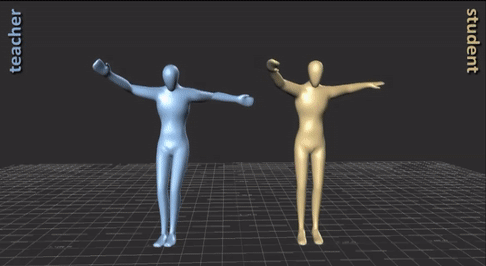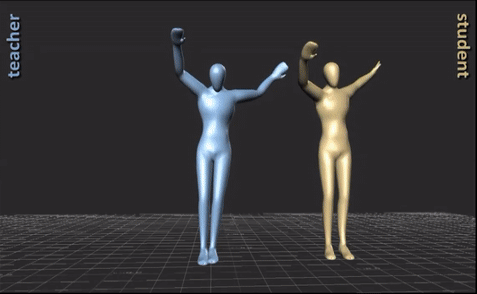Folk Dance Evaluation Using Laban Movement Analysis

Folk Dance Evaluation Using Laban Movement Analysis
Andreas Aristidou, Efstathios Stavrakis, Panayiotis Charalambous, Yiorgos Chrysanthou, Stephania L. Himona
ACM Journal on Computing and Cultural Heritage, 8(4): 1-19, 2015.
Best paper award at EG GCH 2014
We present a framework based on the principles of Laban Movement Analysis (LMA) that aims to identify style qualities in dance motions, and can be subsequently used for motion comparison and evaluation. We have designed and implemented a prototype virtual reality simulator for teaching folk dances in which users can preview dance segments performed by a 3D avatar and repeat them. The user's movements are captured and compared to the folk dance template motions; then, intuitive feedback is provided to the user based on the LMA components.
Other Related Publications
- LMA-Based Motion Retrieval for Folk Dance Cultural Heritage
In Proceedings of the 5th International Conference on Cultural Heritage (EuroMed'14), LNCS, volume 8740, pages 207-216, Limassol, Cyprus, November 3 - 8, 2014.
[DOI] [paper] [bibtex] - Motion Analysis for Folk Dance Evaluation
In Proceedings of the 12th EUROGRAPHICS Workshop on Graphics and Cultural Heritage (GCH), pages 55-64, Darmstadt, Germany, October 5 - 8, 2014. [Best Paper Award]
[DOI] [paper] [bibtex]


This figure shows snapshots from our experimental data, in which the student (yellow) imitates the teacher’s (blue) movements.
Abstract
Motion capture (mocap) technology is an efficient method for digitizing art performances, and is becoming increasingly popular in the preservation and dissemination of dance performances. Although technically the captured data can be of very high quality, dancing allows stylistic variations and improvisations that cannot be easily identified. The majority of motion analysis algorithms are based on ad-hoc quantitative metrics, thus do not usually provide insights on style qualities of a performance. In this work, we present a framework based on the principles of Laban Movement Analysis (LMA) that aims to identify style qualities in dance motions. The proposed algorithm uses a feature space that aims to capture the four LMA components (Body, Effort, Shape, Space), and can be subsequently used for motion comparison and evaluation. We have designed and implemented a prototype virtual reality simulator for teaching folk dances in which users can preview dance segments performed by a 3D avatar and repeat them. The user's movements are captured and compared to the folk dance template motions; then, intuitive feedback is provided to the user based on the LMA components. The results demonstrate the effectiveness of our system, opening new horizons for automatic motion and dance evaluation processes.
Acknowlegments
This work is co-financed by the European Regional Development Fund and the Republic of Cyprus through the Research Promotion Foundation under contract ΔΙΔΑΚΤΩΡ/0311/73.

© 2025 Andreas Aristidou